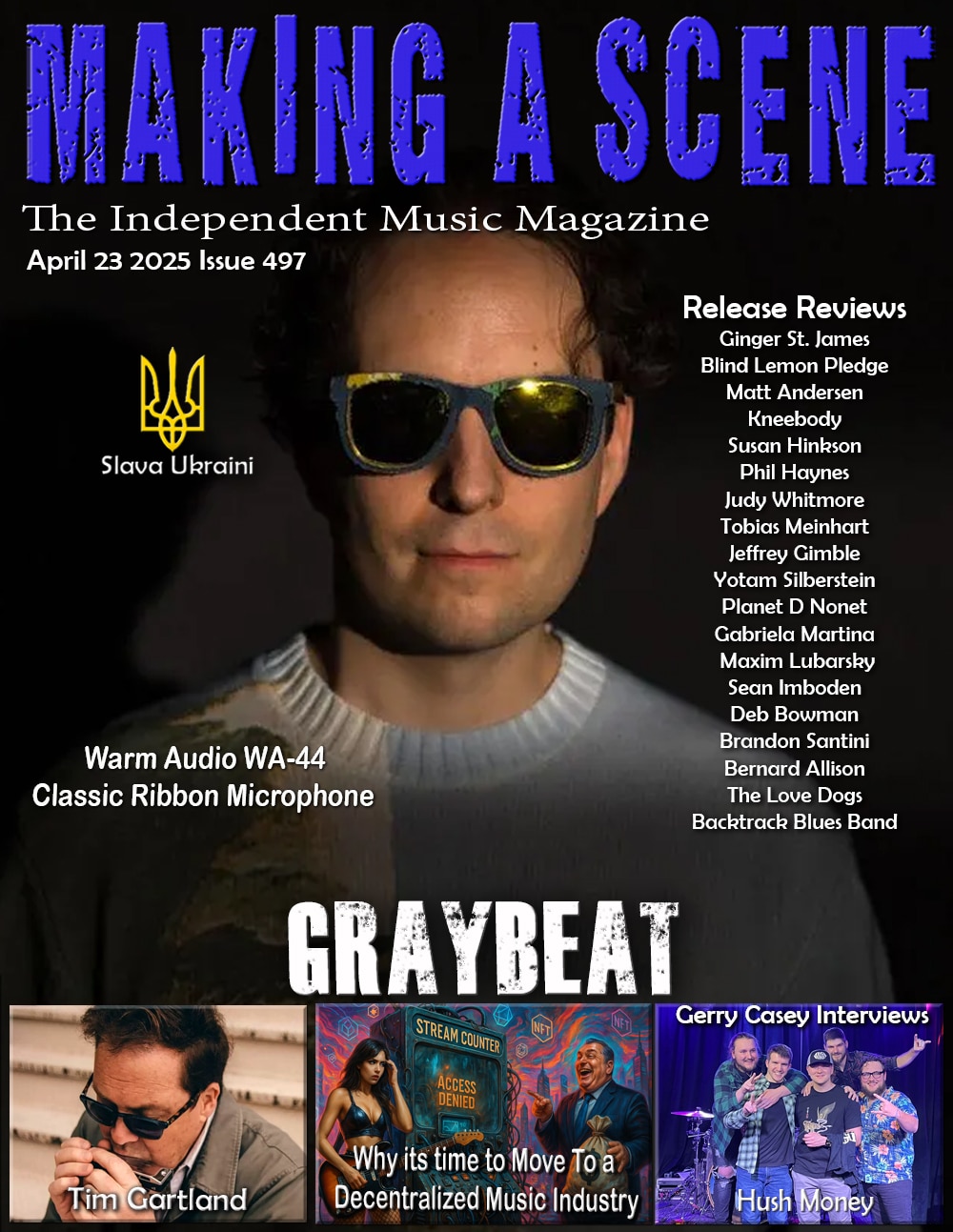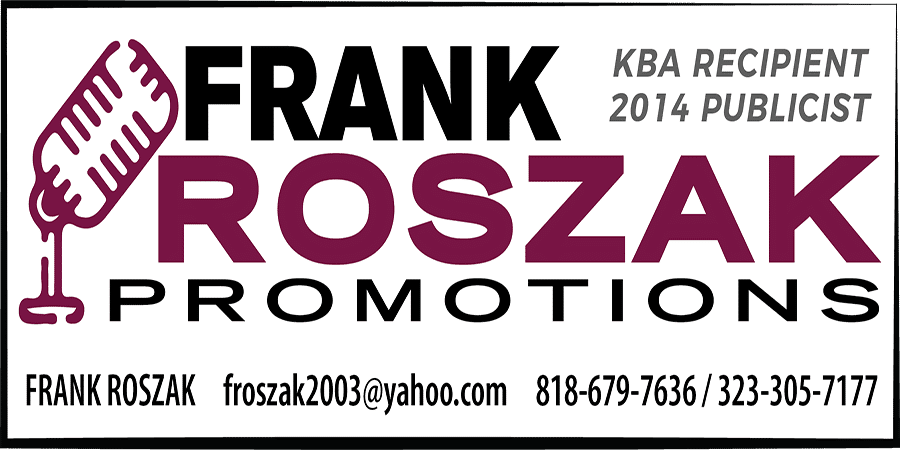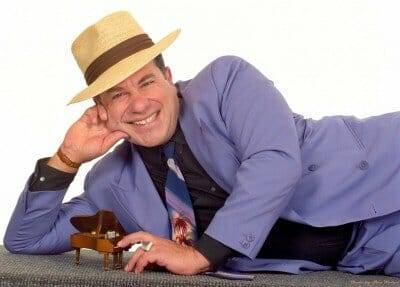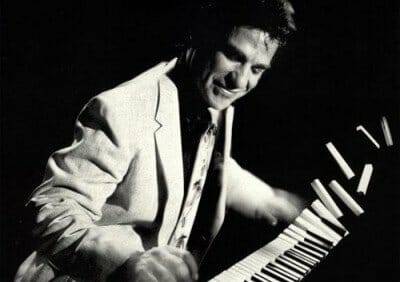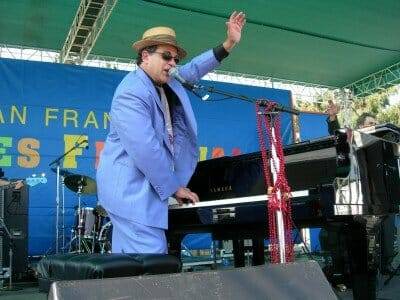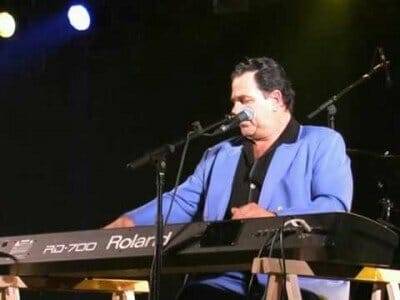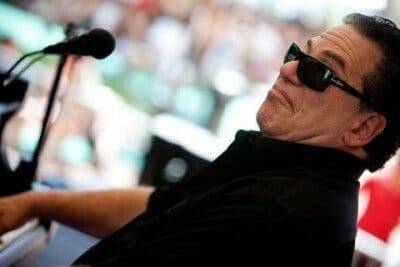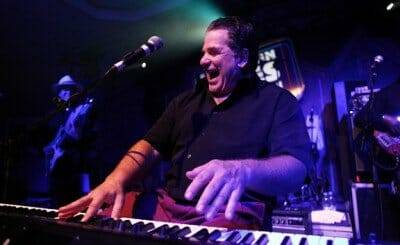An Exclusive Interview with Mitch Woods
An Exclusive Interview with Mitch Woods!! by Richard Lhommedieu on Mixcloud
Jump blues, rock-a-boogie, boogie-woogie – call it what you like, blues fans and piano lovers will Jump For Joy over the new release by Mitch Woods and His Rocket 88s. The San Francisco bluesman, long known for his showmanship and flair onstage, has finally realized a long-running dream; to get back to the jump blues sound of the great big-band Forties. Woods is no mere revivalist – his music appeals to blues lovers and rock and rollers as well as dance fans.
There’s a lot to be excited about on Jump For Joy, Woods says. “This is really my full-on jump blues album. We did it with a big band, it’s all original tunes written as they were back in the Forties.” Woods has an impressive group of sidemen, including Bay Area guitarist Danny Caron, whose credits include music director for Charles Brown, and saxman Michael Peloquin’s velvet horn arrangements. Produced by Woods and Bay Area producer Joel Jaffe, this record really takes the big band motif to heart in a rootsy blues style.
“I think the arrangements of the tunes are a big reason for the big band sound. In keeping with that, we didn’t concentrate on solos per se; I do four piano solos on the whole album,” Woods says. A prolific songwriter who often writes with a humorous bent, he unabashedly calls this batch of original tunes “classics, just really great songs.”
Jump For Joy marks the first time Woods has worked with a producer; he had always self-produced his records before. “With a group this large, it was very helpful to have Joel there, he had a lot of creative input and great ideas,” he says. The end result is all Mitch Woods, however – big, belting boogie tunes with a smooth crooner’s style laced perfectly with his non-stop, pounding piano licks.
Lest anyone sneeringly suggest that Woods is trying to make good on the now-fading swing craze, rest assured that the feisty pianist scoffs at the notion, and with righteousness – years before yuppies discovered vintage duds and the Lindy Hop, Woods was doing his thing. “I consider myself mainly a jump blues player, but for years I would always have swing dancers come down to my show. We always swung,” says Woods.
Anyway, what’s in a name? Woods, ever-vigilant historian of the seminal Forties music scene, likes to point out that self-professed swingers have mislabeled themselves. “What people are calling the swing movement, it’s really jump blues, and that’s what we’ve been playing since we started, and that’s why we fit in the swing movement. They call it swing, but it’s jump. The best dance music is jump blues, period.” Mitch Woods and His Rocket 88s have always borne the torch for this uniquely American blues musical heritage, not for two years but two decades. Taking their inspiration from the great jump n’ boogie outfits of the late 40s and early 50s, they breathe fresh life into the music that gave birth to rock n’ roll.
Woods styled his group after the jumpin’ n’ jivin’, shoutin’ n’ honkin’, pumpin’ n’ poundin’ bands of Louis Jordan, Wynonie Harris, Joe and Jimmy Liggins, Amos Milburn, and Roy Milton. Adding a healthy dose of New Orleans rhythm and blues, piledrivin’ piano, and some of his own contemporary playful lyrics, Woods and His Rocket 88s forge their own brand of music they call “rock-a-boogie.”
Born in Brooklyn in 1951, Mitch Woods began playing classical piano at eleven, but his real initiation into blues and boogie piano had already been assured at age eight. “My mom would hire this superintendent of the building, a black man, Mr. Brown, to take me to school, and we stopped off at his cousin’s house, where somebody was playing boogie-woogie piano. It really hit me.”
Woods was putting together bands in Greenwich Village by his mid-teens. By the time he entered the University of Buffalo, Woods was sitting in at local clubs and discovering records by boogie woogie pioneers Meade Lux Lewis, Albert Ammons, and Pete Johnson. It was during a class on Afro-American music taught by noted jazz sax player Archie Shepp in 1970 that Woods finally realized he was bound to be a pianoman.
Perhaps it was Shepp, a known curmudgeon, who cemented his resolve in an offhand way, Woods remembers. “I was very interested in learning about this music, but it turned out to be reverse racism, he was putting down white people a lot, and I was one of about three white kids there, but I had a love for black music, I wanted to learn about it. Blues and jazz, I wanted to learn about that culture, where this music came out of, and he said, ‘There’s no white guy that can play the blues,’ and I said ‘Hey, I don’t agree with you.'” “He said, ‘Well go ahead and name me one white guy who can play the blues,’ and I named guys like Mike Bloomfield, Paul Butterfield, he says ‘They’re not so great,’ and I said ‘Well, I can play.'”
As if to say “oh yeah?,” Shepp challenged Woods to attend a local jam session. “I steeled my nerves, I went down to the session, and fortunately for me there was no piano there, but at that point he respected the fact that I came down.” That broke the ice – Shepp gruffly accepted Woods and they became close. “He started telling me about who to listen to, but he still kept his opinions.” Woods came to San Francisco in 1970, and for the next five years performed as Mitch Woods and His Red Hot Mama (with singer Gracie Glassman). One night Oakland guitarist HiTide Harris heard Woods opening for Charlie Musselwhite and was reminded of the sound and theatrics of early R&B pioneer Louis Jordan. Indeed, Jordan has always been a primary influence on Woods. “I actually did see Louie Jordan in Oakland. He was the bridge between swing and rock and roll. He would do a five or six piece band, get a lot of power out of that.”
That kind of power was to become rallying cry for Mitch’s next project, Mitch Woods and His Rocket 88s, which started in 1980 and quickly rose to the top of the Northern California club circuit. Their first album, Steady Date (Blind Pig Records) got hot reviews in 1984 and led to appearances at two San Francisco Blues Festivals, openings for the Fabulous Thunderbirds, Stevie Ray Vaughan, The Blasters, The Neville Brothers, and James Brown. By 1987, Woods was doing a six-country Europe tour highlighted by a rousing performance at the Belgium Rhythm and Blues Festival.
In 1988, the 88s released Mr. Boogie’s Back In Town (Blind Pig Records) and music pundits started to acknowledge Woods’ place in the ranks of American music: “Woods lays down an authentic 50s-vintage rock piano groove, comparable in power and and rhythmic nuance to classic recordings by the young Jerry Lee Lewis,” said Keyboard Magazine.
On 1991 album Solid Gold Cadillac, Woods and his band were joined by Ronnie Earl, Charlie Musselwhite and the Roomful of Blues Horns. Woods himself was starting to become a guest star, appearing on that year’s new releases by John Lee Hooker and John Hammond, and the boogie pianist headlined both the Amsterdam Blues Festival and the Montreal Jazz Festival.
Woods was developing his passion for bandleading and discovering the power of being a strong singer. “I’ll always consider myself a piano player, but my voice has developed over the last few years. It’s an incredible release, when you can sing, it’s like blowing an axe, and it’s great to entertain an audience,” he says. Another interest was taking hold, too – the funky piano-driven music of New Orleans. Woods had long been infatuated with the music of the Big Easy. “I’m a boogie woogie and blues piano player for the most part, but I also incorporate other styles within that, like the New Orleans influence. New Orleans R&B piano playing, like Dr. John, of course Professor Longhair. I’ve been going to jazz festival every year, performing at the clubs; I played piano night at Tipitina’s.”
“New Orleans has been a really great source of inspiration, it’s a piano town. New Orleans reveres the piano player. People respect me and I appreciate that. I’ve always been able to feel a real sense of music there; if you’re a good player, you get in. I work there as much as I can,” Woods says. “I’ve gotten to play with all the great players who live there, and I just hire them, guys from Fats Domino’s band, like Red Tyler, sax player, Johnny Vidakovich, drummer with the Professor, and George Porter on bass.
Woods toured constantly in the mid-1990s, stopping long enough to put out Shakin’ the Shack (Blind Pig Records) in 1998. Woods wrote all but one song, demonstrating how well he’s absorbed the conventions of blues and boogie woogie music, further proving his ability to inject new life into these vintage forms. Woods also realized another dream in 1998 when he brought together some of the surviving kings of the American blues legacy, like John Lee Hooker, James Cotton, Johnnie Johnson, Earl King and Lee Allen, to make Keeper Of The Flame (Lightyear/WEA Records), all paired with Woods in a wonderful run of classic tunes.
The new album continues Woods’ spin down the boogie road. He had always followed the boogie greats like Louie Jordan and Louie Prima, but Jump For Joy keyed off a new influence. “I started to listen to Cab Calloway, and this new one has lots of Cab influence; six horns, eleven-piece band with doubled horn lines. He (Calloway) had a great entertainment style, very similar to Louie Jordan’s, and that’s what we’ve gone for here,” he says.
Woods says Jump For Joy will unite all factions in the dress-up-and-boogie scene. “Aside from the blues audience, we’ve been developing the whole swing crowd, so this will appeal to the swing dancers as well as the blues lovers.” It’s about time; the swing fad is peaking and Mitch Woods is the perfect practitioner to school all those wannabe acts that were all fluff and no stuff. “I’ll always play my music, whether it’s the in thing or if there’s only two people in the bar, and it will feel just as good either way!”
So get your saloon shoes and dig Jump For Joy! Mitch Woods has gone the limit, writing sassy boogie tunes and crafting smooth arrangements that evoke the heyday of the dancehall Forties. When you grab onto this fine batch of swingin’ tunes, you’ll just want more from Woods and his infectious boogie jump blues.
– Ed Ivey
Discover more from Making A Scene!
Subscribe to get the latest posts sent to your email.





































